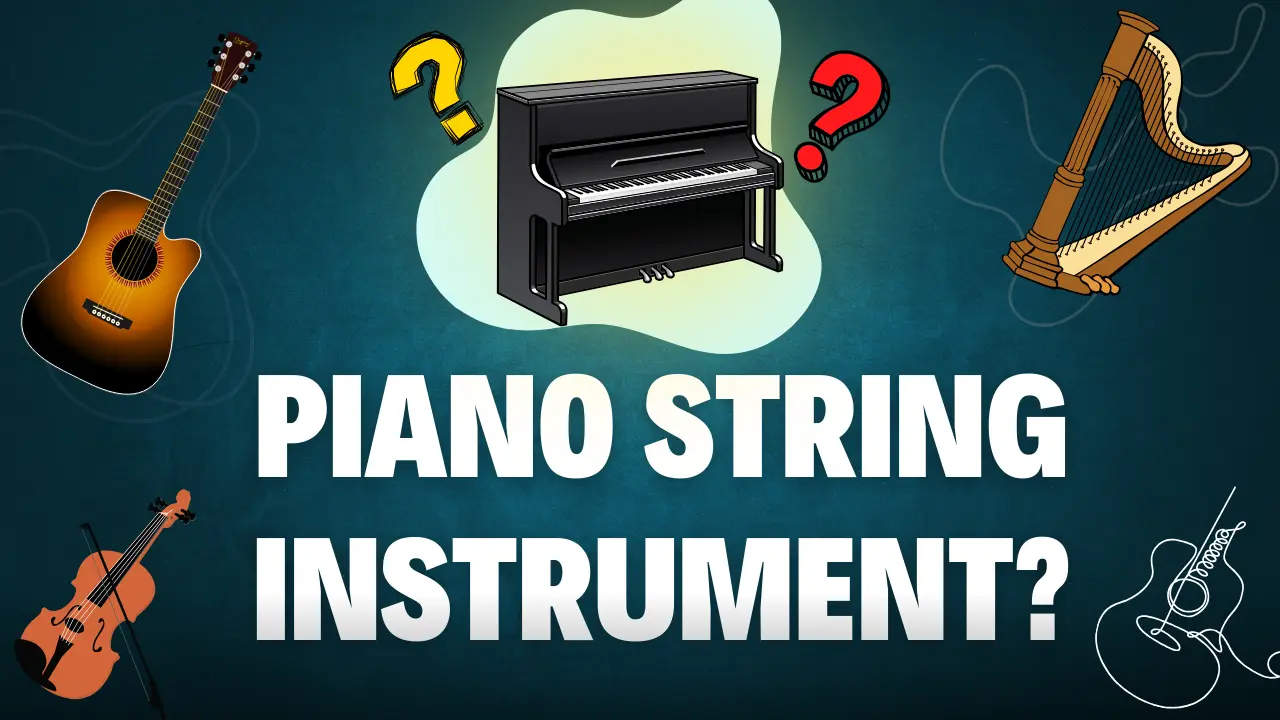At first glance, the piano is often associated with its keys and the grand, majestic sound it produces. It’s easy to think of it purely as a keyboard instrument, but there’s much more to this instrument than meets the eye. So, is the piano a string instrument? The answer is both yes and no, which is why the piano is such a fascinating piece of musical history. In this blog, we’ll dive into the details of why the piano is considered a hybrid instrument, the mechanics behind it, and why it doesn’t fit neatly into one single category.
Understanding Musical Instrument Classifications
Before diving into know whether a piano a string instrument, let’s first approach musical instruments taxonomy. The most widely accepted system for classifying instruments is the Hornbostel-Sachs system, which was introduced in 1914. This system allows the instruments to be divided on the basis of where the sound is generated. The major categories are:
- Idiophones: Instruments that produce sound through the vibration of the entire instrument (e.g., xylophone, cymbals)
- Membranophones: Instruments that produce sound through vibrating membranes (e.g., drums)
- Chordophones: Instruments that produce sound through vibrating strings (e.g., violin, guitar)
- Aerophones: Instruments that produce sound through vibrating columns of air (e.g., flute, trumpet)
- Electrophones: Instruments that produce sound through electronic means (e.g., synthesizer)
The Piano’s Unique Construction
For the sake of proper classification, there is a need to take a closer look at the piano’s construction. In fact, the piano is an intricate instrument, which is constructed out of numerous parts but the really essential ones for our conversation are:
- The strings: The piano has many metal strings stretched across a frame
- The hammers: The felt-covered wooden hammers knock against the strings to generate sound
- The soundboard: A heavy wooden board that is used to vibrate the strings
- The keys: The white and black keys on piano which one recognizes when one pushes them activate the strings via the hammers
The piano’s strings are the foremost source of its sounds. When you press a key, it results in a corresponding hammer hitting the string or strings and in this way sets them into oscillation. The soundboard then amplifies these vibrations, thus the piano gets its beautiful tones from it.
Classification of the Piano
To answer a question is piano a string instrument? it is important to understand the classification of piano. Possibly, the piano is not only the chordophone but also the string instrument. The strings are the main source of sound, which makes it belong to the same category with the violin, guitar, and harp.
Nevertheless, the piano is not just a string instrument. It is part of the chordophone group that plays on the strings or it can be referred to as the “struck string instrument.” What happens is that the hammers hit the strings and produce sound, which differs from the string instruments in which the strings are plucked (e.g., a guitar) or bowed (e.g., a violin).
The Piano’s Dual Nature
Even if the piano is labeled as a string instrument, it is important to mention that it also has relevance to percussion instruments in some respect. In the process of the hammer hitting the string, a percussive action occurs that is similar to the way a mallet hits the bars of a xylophone. The piano’s double nature has even been used as a title by some writers, so they call it “percussion-stringed” instrument.
The combination of the string and percussive elements of a piano has been a major factor in its wide application as well as the production of a wide range of sound from soft and melodious to harsh and rhythmic.
Historical Development of the Piano
If you want to gain a robust understanding of the piano’s classification, you have to first look at the way it has been developed through history. The piano came out of the former string instruments, especially the harpsichord and the clavichord. They were all string instruments to be honest.
- The harpsichord, which creates a musical tone by pressing quills against the strings, was quite popular in Baroque music. But there were still limitations regarding dynamic control, the issue of all notes getting the same volume was a survival problem for the pianist.
- The clavichord, which uses small metal blades called tangents to strike the strings, subjected the performing musician to the control problem even though it had the advantage of better capabilities of dynamic control but because of the loss of a clear sound quality, it was improper for large-scale performance spaces.
The piano, invented by Bartolomeo Cristofori approximately in 1700, was made for the purpose of solving the defects just mentioned. By stringing hammers that have to hit the strings, Cristofori created an instrument that joined the best aspects of a harpsichord, i.e., volume or a clavichord, i.e., dynamic control.
The Piano in Modern Music
Currently, you might expect that the piano is classified as a string instrument but it varies in many cases from its modern utility. It is not an uncommon sight to see pianos doubling as melodic and rhythmic instruments of an ensemble, sometimes even in orchestra scores being listed with the percussion instruments.
Its flexibility is what makes the piano one of the leading instruments. It is the ability to produce both continuous and percussive sounds that jelly its role in so many different musical genres, from symphonies to pop.
Comparing the Piano to Other String Instruments
When comparing the piano to other string instruments, the difference in how sound is produced becomes clearer. On a guitar or violin, the musician plucks or bows the strings directly. This gives them direct control over the sound. In contrast, piano players rely on the keys and hammers to create sound, removing that direct interaction with the strings. However, like these traditional string instruments, the quality of the piano’s sound is still fundamentally tied to the properties of its strings.
In some ways, the piano can be seen as a more complex string instrument. While a violinist may only deal with four strings, a piano player engages with over 230 strings across its range. Each note on the piano can involve two or three strings tuned to the same pitch to amplify the sound, especially in the higher registers.
Conclusion
So is piano a string instrument? Despite the piano presenting a real intricate structure at times, the basic truth is that it is mainly a string instrument. The strings are the main sound sources and that puts it into the chordophone category. However, besides its uniqueness in struck-string mechanism and percussed characteristics, it acts for itself as well, contributing to its rich, diverse, and pivotal position in music.































